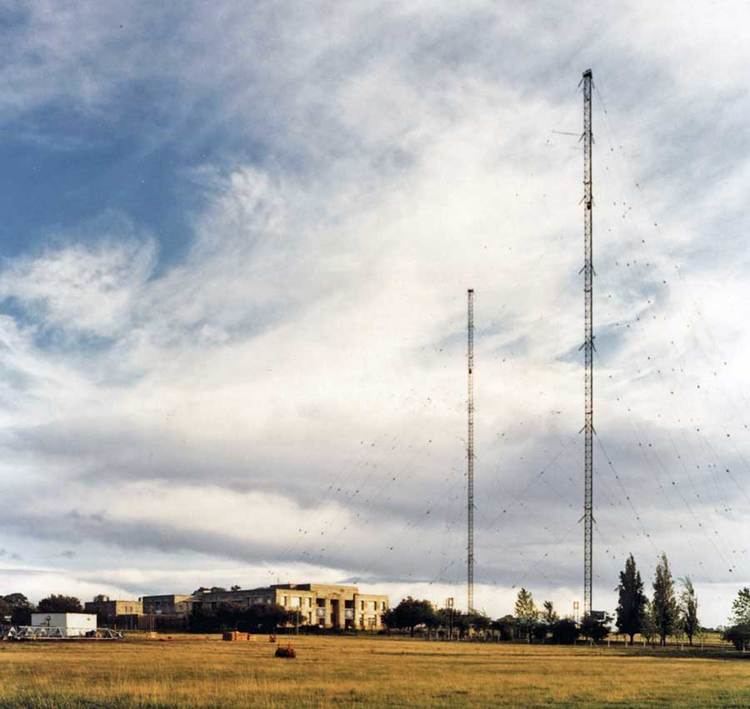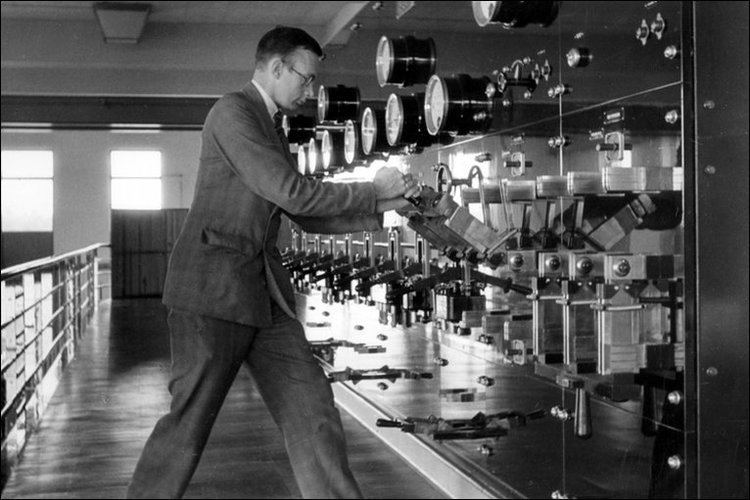Mast height 213.36 metres (700 ft) Year built 1934 | Grid reference SO929663 | |
 | ||
Location Droitwich, Worcestershire | ||
The Droitwich transmitting station is a large broadcasting facility for long-wave and medium-wave transmissions, established in 1934 in the civil parish of Dodderhill, just outside the village of Wychbold, near Droitwich in Worcestershire, England (grid reference SO929663). The site is the location of the British Broadcasting Corporation's most powerful long-wave transmitter, which together with the two Scottish long-wave transmitters at Burghead and Westerglen forms a network broadcasting on the same frequency. The masts can be seen to the east from the M5 motorway, between Droitwich and Bromsgrove. At night, the two sets of aircraft warning lights are visible from a long distance. The station is owned and operated by Arqiva.
Contents

Technical specifications

The long-wave frequency used was 200 kilohertz until 1 February 1988 when it was changed to 198 kilohertz, and the power is currently 500 kilowatts. The carrier frequency is controlled by a rubidium atomic frequency standard in the transmitter building, enabling the transmission to be used as an off-air frequency standard. For long-wave, a T-aerial is used, which is suspended between two 213-metre-high (700 ft) guyed steel lattice radio masts, which stand 180 metres (590 ft) apart from each other. There are also two guyed mast radiators at the site, which are used for transmitting AM medium-wave radio programmes on 693 kilohertz, 1053 kilohertz and 1215 kilohertz.
Transmissions

BBC Radio 4 Longwave is transmitted on 198 kHz. A number of items in the BBC Radio 4 schedule are carried on the long-wave (LW) frequency only: these include Yesterday in Parliament at 0835–0900 on Tuesdays to Fridays, The Daily Service at 0945–1000 on Mondays to Fridays, the Shipping Forecast at 1201–1204 daily and 1754–1757 on Mondays to Fridays, and Test Match Special during international cricket games.

The Radio 4 LW signal also carries radio data encoded using phase modulation, giving a time-of-day signal, and radio teleswitch control signals for Economy 7 electric-heating systems.
BBC Radio 5 Live is broadcast on 693 kHz medium wave (MW), providing coverage for most of the English Midlands and Wales at a signal strength (150 kW) which is one of the strongest for that station, equal to Brookmans Park and second only to Moorside Edge.
During World War II coded messages, read during normal programme broadcasts, were sent to the French Resistance using the transmitter.
In 2011 as part of the BBC cuts it was announced that there would be no re-investment in long wave which may mean an eventual end to BBC Radio 4 in this part of the radio spectrum. The Guardian published a story in October 2011 saying that the transmitter relies upon a pair of glass valves, of which there are fewer than 10 left in the world, and the BBC did not believe it was safe enough to manufacture more. However, ex-BBC engineers say the valves are ceramic, not glass and these valves can be made to order, perfectly safely.
Reception
The Radio 4 LW signal from Droitwich covers most of England and Wales. There are supplementary long-wave transmitters in Scotland (Burghead and Westerglen, both 50 kW), with medium-wave transmitters in various parts of England, Scotland and Northern Ireland. The station can also be heard clearly in most of the Republic Of Ireland, particularly along eastern and southern counties. Reception is also possible in Western Europe, including Italy. However, since March 2014 the BBC is doing works in the transmitter that result in a very weak signal reception in Europe. As of March 2015, the reception of BBC Radio 4 LW 198 kHz is still very poor and difficult, even in the countries next to the UK in continental Europe.
In July 2016, 198 kHz can be received clearly in the centre of Germany.
